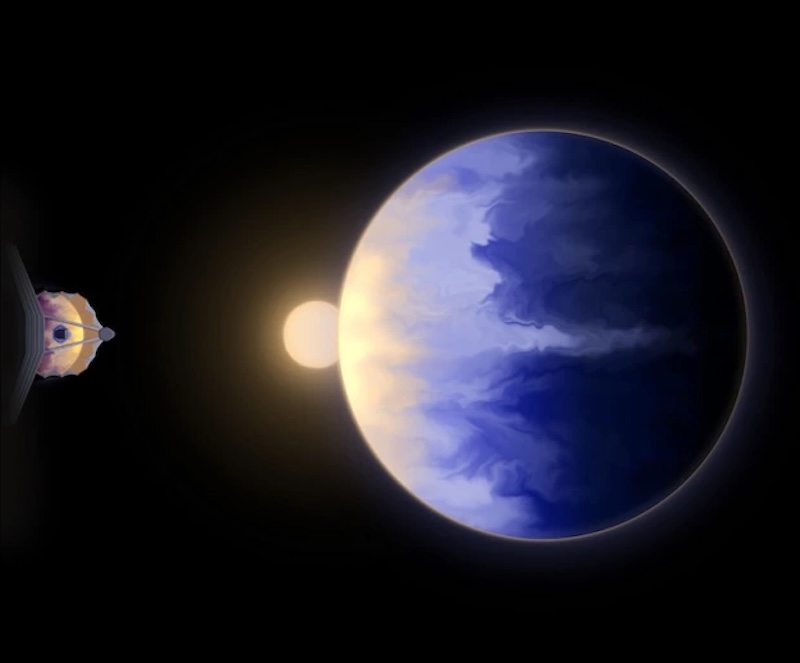
- WASP-107 b is a gas giant exoplanet about 210 light-years from Earth. It’s a bit smaller than Jupiter, but much less massive.
- Its atmosphere is asymmetric from east to west. It’s the first time astronomers have detected such an asymmetry on an exoplanet while it is passing in front of its star.
- The planet is also “puffy”, with an atmosphere inflated much more than it should be for the planet’s mass.
An exoplanet with a weird atmosphere
Astronomers have observed a uniquely hot, inflated and asymmetric exoplanet using the James Webb Space Telescope. About 210 light-years from Earth, WASP-107b is about 3/4s the size of Jupiter but only a 10th of its mass. A team of researchers, led by the University of Arizona, said on September 24, 2024, that it has an east-west asymmetry in its atmosphere. It is the first time scientists have seen such an asymmetry on an exoplanet while it is transiting its star. The planet also has a “puffy” atmosphere that is more inflated than usual for a planet of its mass.
The researchers published their peer-reviewed findings in Nature Astronomy on September 24, 2024.
Webb observes WASP-107 b
Webb has observed WASP-107 b before, and scientists knew about its puffy atmosphere. For the newest observations, the researchers used transmission spectroscopy. That’s the analysis of light waves as they pass through an atmosphere. Basically, Webb tracked the planet as it transited – passed in front of – its star, taking “snapshots” as the planet moved. This allowed Webb to analyze the planet’s atmosphere. Lead author Matthew Murphy at the University of Arizona said:
These snapshots tell us a lot about the gases in the exoplanet’s atmosphere, the clouds, structure of the atmosphere, the chemistry and how everything changes when receiving different amounts of sunlight.
Webb was able to take extremely precise measurements of WASP-107 b’s atmosphere. Despite the planet still being too far away to actually photograph, Webb examined the spectroscopic details of both its western and eastern hemispheres.
In addition, WASP-107 b is also tidally locked to its star. That means one side of the planet always faces the star, much like how the same side of the moon always faces Earth. This creates a permanent day side and permanent night side on WASP-107 b.
An asymmetric atmosphere
Webb found something interesting: an east-west asymmetry. What is an east-west asymmetry? It’s when there are differences in a planet’s atmosphere between its western and eastern hemispheres. For example, this can include temperature or other cloud characteristics, which make the two hemispheres distinct from each other.
On WASP-107 b, Webb found significant temperature differences between the morning and evening limbs. The paper stated:
We infer instead a morning-to-evening temperature difference of the order of 100 K with a hotter evening limb.
In fact, this is the first time scientists have seen such an asymmetry on an exoplanet while it transits its star. Murphy said:
This is the first time the east-west asymmetry of any exoplanet has ever been observed as it transits its star, from space. I think observations made from space have a lot of different advantages versus observations that are made from the ground.
We don’t have anything like it in our own solar system. It is unique, even among the exoplanet population.
For almost all exoplanets, we can’t even look at them directly, let alone be able to know what’s going on one side versus the other. For the first time, we’re able to take a much more localized view of what’s going on in an exoplanet’s atmosphere.

A hot, mysterious world
Overall, WASP-107 b is a scorching hot world, with temperatures around 890 degrees Fahrenheit (750 K or 480 Celsius). That places it between the cooler giant planets like those in our own solar system and exoplanets that are even hotter. The observations have produced many questions. Scientists didn’t even expect to find the asymmetry they did. As Murphy explained:
Traditionally, our observing techniques don’t work as well for these intermediate planets, so there’s been a lot of exciting open questions that we can finally start to answer. For example, some of our models told us that a planet like WASP-107 b shouldn’t have this asymmetry at all, so we’re already learning something new.
The researchers are planning additional observations of WASP-107 b. These will help better understand the processes happening in its atmosphere, which make the planet so unique.
WASP-107 b is one of the least-dense exoplanets found so far. It also has much less methane in its atmosphere than astronomers thought. This suggests WASP-107 b is hotter on the inside and has a larger core than astronomers expected. Plus, tidal heating is likely causing this, explaining the planet’s puffiness. The gravitational pull of the star is greater when the planet is closer and less when it is farther away. This causes stretching to the planet’s interior, heating it in the process.
Bottom line: New observations by the Webb space telescope show the giant exoplanet WASP-107 b has an asymmetric atmosphere between its western and eastern hemispheres.
Source: Evidence for morning-to-evening limb asymmetry on the cool low-density exoplanet WASP-107 b
Read more: Webb solves mystery of puffy exoplanet WASP-107 b











